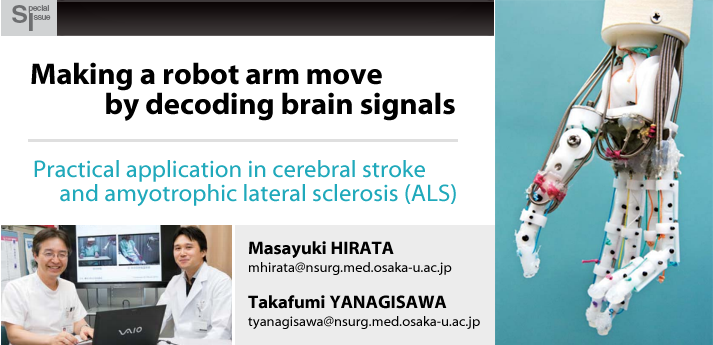
Making a robot arm move by decoding brain signals -- Practical application for patients with cerebral stroke and amyotrophic lateral sclerosis (ALS)
Under the leadership of Professor
Toshiki YOSHIMINE
at the Department of Neurosurgery, a group of researchers including Specially Appointed Associate Professor
Masayuki HIRATA
and Assistant Professor
Takufumi YANAGISAWA
having succeeded in creating a robot arm that moves in real time by decoding brain signals thanks to a brain-machine interface (BMI). On the brain/human side, this BMI consists of small sheets with electrodes that are afixed to the brain surface in persons with long-term motor paralysis. Brain signals from these electrodes are passed on to a computer which reads and decodes them, thereby inferring the user's intentions regarding movement. In this way, patients with severe motor disabilities are able to make a robot or electric appliance follow their commands.
After obtaining approval from the Research Ethics Committee, this device was tried out on 12 patients with epilepsy as part of their therapy with their agreement. By making the computer learn from the brain surface electrodes, post-stroke patients with one-sided paralysis became able to make the robot move, grasp or raise an object by means of their brain signals.


Report on interview with Specially Appointed Associate Professor Masayuki HIRATA and Assistant Professor Takufumi YANAGISAWA
Specially Appointed Associate Professor Hirata : There are some 7,000 ALS patients, 40,000 patients with cervical cord injury, 150,000 patients with amputated limbs, and 1.5 million patients suffering from cerebral stroke. My hope is that these people will be able to live more comfortably using a robot arm for their own limbs.
 However, this technology cannot be fully achieved until there is a well-balanced development in a variety of fields including medicine. The most critical technology is to understand what the measured brain signals mean -- what brain signals are emitted for each motion, what a person is going to do, squeeze or open their hand, bend or stretch their leg.
However, this technology cannot be fully achieved until there is a well-balanced development in a variety of fields including medicine. The most critical technology is to understand what the measured brain signals mean -- what brain signals are emitted for each motion, what a person is going to do, squeeze or open their hand, bend or stretch their leg.
There have been some BMI communication devices by which a patient stares a letter on a board and "clicks" on it by blinking. If a machine can decode the patient's brain signals and move a cursor, words can be spelled faster. It has been proven that, in the case of paralized patients, just imagery of movement can induce high-frequency brain signals from the area of the brain responsible for the movement and make a robot move, although there are differences in the level of the messaging accuracy between those who can easily imagine and those who cannot.
As we deal with intimate personal information of the brain, it's important to consider the ethics involved in this neuroscience. What patients want to hide must not be brought out into the open. To this end, we are working on setting up guidelines for development and for clinical trials and are conducting nationwide surveys to understand patients' needs. At Osaka University, full-fledged research will start at the Center for Information and Neural Networks. Researchers from multiple fields will conduct intensive research into the brain there. We aim to put our technology to practical use within ten years. We need to promote not only technologies, but also guidelines, quick application for authorization, and more. I think if we achieve breakthrough results, the scope of application will further expand.
 Assistant Professor
Yanagisawa:
I'm studying the flow of brain signals that are picked up as we attempt to infer movement and make the robot move. In Osaka University Hospital, the number of patients being studied is only 4 or 5 a year. In order to conduct research using such a limited number, we need to make detailed plans. Brain signals for instructing robots on motions such as grasping or releasing an object differ according to the motion. By examining them we can find common characteristics and infer brain signals for each motion, make assumptions that this signal corresponds to this motion or that.
Assistant Professor
Yanagisawa:
I'm studying the flow of brain signals that are picked up as we attempt to infer movement and make the robot move. In Osaka University Hospital, the number of patients being studied is only 4 or 5 a year. In order to conduct research using such a limited number, we need to make detailed plans. Brain signals for instructing robots on motions such as grasping or releasing an object differ according to the motion. By examining them we can find common characteristics and infer brain signals for each motion, make assumptions that this signal corresponds to this motion or that.
It's only Osaka University that is working on such measurements using electrodes on the brain surface for motor actions. Researchers in various fields such as medicine, engineering, and ethics are involved in this research.